Table of Contents
Rise of New Japan
Context: Japan’s recent geopolitical shift, marked by Prime Minister Fumio Kishida’s address to the United States Congress and developments from his summit meeting with President Joe Biden, signals the emergence of a more assertive Japan on the world stage.
Japan’s Shift from Pacifism to a More Assertive Role in Asia
- Following World War II, Japan embraced a policy of pacifism, refraining from significant military buildup and avoiding involvement in conflicts.
- Japan’s pacifist stance was reinforced by its alliance with the United States, allowing it to concentrate on economic recovery and technological advancement.
- By the turn of the 1970s, Japan became the world’s second largest economy, behind only the US.
- In the mid 2000s, Japan began to articulate ideas for a new security architecture in Asia, promoting concepts like the Indo-Pacific.
- Since then, Japan has invested enormous diplomatic, political, and financial resources to popularise this geopolitical construct that was eventually adopted by Australia, Indonesia, India, and the United States.
- Now, Japan is transforming its famed civilian industrial capability into a military industrial complex, and turning from being a US protectorate into an American partner and a significant contributor to Asian and Indo-Pacific security.
- This shift is driven by a combination of external and internal factors.
- External Factors:
- China’s growing military assertiveness, particularly in disputed territories with Japan.
- Strengthening military ties between China and Russia.
- North Korea’s advancing military capabilities.
- Concerns about US commitment to Asian security under the Trump administration.
- Internal Factors: Rise of conservative voices advocating for a “normal power” Japan taking responsibility for its own security.
- External Factors:
Japan’s Military Buildup
- Japan has done away with the historical cap on defence expenditure
- According to data from the World Bank, in 2020, Japan’s military expenditure touched 1% of GDP for the first time in six decades.
- Also pledged to double annual defence spending to around 10 trillion yen ($68 billion) by 2027, which would make Japan the world’s third-biggest military spender after the US and China.
- Japan has acquired, and is in the process of further acquiring, its own counter-strike capability in the form of cruise missiles.
- Japan’s cabinet relaxed its self-imposed ban on exports of lethal weapons to friendly nations. This decision enables Japan to leverage its substantial manufacturing and technological prowess to support allies.
- Collaborating with the US on joint military production and revising command structures.
- For instance, both countries finalised the establishment of a joint military industrial council to facilitate co-production of weapons.
Changes in Japan’s Diplomatic Posture
- Reconciliation with South Korea: Japan has attempted to mend historical rifts with South Korea stemming from Japan’s occupation of the Korean peninsula (1910-1945).
- This improved relationship facilitates stronger regional security cooperation and allows the US to transition from a system of bilateral alliances to a more collaborative regional security network in Asia.
- Support for Ukraine: Japan has emerged as a key supporter of Ukraine in the war with Russia.
- It has provided significant aid for reconstruction and even sent some weapons.
- Notably, Japan is the sole Asian nation to take a clear stance on defending Ukraine’s territorial sovereignty.
India’s Response to Japanese Policy Changes
- India has not officially responded to Japan’s recent policy shifts.
- Historical ties: India acknowledged Japan’s historical role in Asia, with figures like Subhas Chandra Bose seeking support from Imperial Japan during the independence movement.
- Prime Minister Jawaharlal Nehru advocated for both China and Japan to contribute to shaping post-war Asia.
- Bilateral relations between India and Japan have taken on a political dimension over the past two decades.
- However, there remains untapped potential for military cooperation between the two countries.
- India views a politically determined and militarily robust Japan positively, as it contributes to the goal of establishing a multipolar Asia within a multipolar world framework.
Green Credit Programme
Context: The Green Credit program incentivizes environmental actions but raises concerns about loopholes and potential harm to forest ecosystems.
About Green Credit Programme: An Overview
- It was announced by the Environment Ministry in October 2023
- It is an innovative market-based program to encourage environmental action.
- The Green Credit Programme offers incentives termed ‘green credits‘ to individuals and companies for environmental contributions.
- Launched as part of the LiFE (Lifestyle for Environment) initiative.
- Administrator: Indian Council of Forestry Research and Education (ICFRE) implements, manages, monitors and operates the program.
Goal
- Incentivize voluntary environmental actions by individuals, communities, industries, and companies.
- Promote sustainable lifestyles and environmental conservation.
Covered Activities
- Tree Plantation: Increase green cover and fight deforestation.
- Water Management: Conserve water resources through efficient management.
- Sustainable Agriculture: Promote eco-friendly farming practices.
- Waste Management: Reduce pollution through effective waste management systems.
- Air Pollution Reduction: Improve air quality with initiatives to reduce air pollution.
- Mangrove Conservation and Restoration: Protect and restore vital mangrove ecosystems.
| Green Credit Management System |
|
What are the Challenges?
- Potential for misuse: The program might be used as a loophole to bypass existing environmental laws, particularly forest conservation regulations.
- Focus on monoculture plantations: The program incentivizes planting trees, potentially leading to monoculture plantations or ‘green desert’ which harm biodiversity.
- Inadequate forest ecosystem protection: The guidelines focus on planting trees instead of protecting existing natural ecosystems.
- Measurement challenges: Accurately measuring the environmental benefits of different activities (e.g., biodiversity impact) is difficult.
- Fungibility issues: Equating credits from various activities (e.g., water conservation vs. carbon sequestration) on a single trading platform poses a challenge.
- Clashes with existing laws: The program might contradict existing environmental laws like the Forest Conservation Act, particularly regarding forest clearance procedures.
- Carbon trading issues: The program’s provision of using green credits in carbon trading is contentious due to the unclear methodology for equating stored carbon from trees with carbon credits.
Proposed Solutions
- Improved program design: The program guidelines should be revised to better consider:
- Protecting existing natural ecosystems alongside afforestation efforts.
- Incentivizing planting native species over monocultures.
- Developing a robust system for measuring the environmental benefits of various activities.
- Strengthening social safeguards: The program should involve civil society and ensure transparency in measurement and verification processes.
- Addressing fungibility: The limitations of fungibility should be acknowledged, and separate markets for different types of green credits might be considered.
- Ensuring compliance with existing laws: The program should be designed to complement, not contradict, existing environmental regulations.
Climate Change
Context
- 2023 was the hottest year on record, and climate models predicted even hotter temperatures in the future.
- As urbanisation increases, cities will become hotter and more humid, creating dangerous heat waves.
Health Consequences of Climate Change
- Climate change, primarily through global warming, harms human, animal, and plant health in various ways:
- Direct heat exposure
- Extreme weather events
- Water scarcity
- Increased infectious diseases
- Worsened non-communicable diseases (NCDs) like strokes, heart attacks, diabetes, respiratory diseases, and mental health disorders
- Food insecurity due to reduced crop yields and nutrient quality
Heatwaves and Human Health
- Heatwaves combine high temperatures with high humidity, making them particularly dangerous.
- Heat stress can lead to dehydration, overheating, and blood vessel problems, increasing the risk of:
- Heat exhaustion
- Heatstroke
- Circulatory failure
- Death
- Infants, young children, elderly adults, people with disabilities, those with pre-existing medical conditions, and women are more vulnerable to heatwaves.
Heatwaves and Non-Communicable Diseases (NCDs)
- Heatwaves can worsen NCDs, a leading cause of death in India (contributing to 65% of deaths).
- Heat exposure can increase the risk of:
- Stroke
- Heart attack
- Kidney damage
- Cataracts in babies
- Impaired wound healing
- A global study found a heatwave-related 11.7% increase in mortality, with the highest risk for stroke and coronary heart disease.
Wildfires and Health
- Wildfires, triggered by heat, release harmful pollutants like PM 2.5, ozone, and carbon monoxide, increasing the risk of:
- Cardiovascular diseases
- Respiratory diseases
- Diabetes
- Cancer
Impact on Food Security
- Climate change threatens food security by harming crop yields and reducing the nutritional content of crops.
- A 1°C temperature rise could decrease yields of staple crops like rice and wheat by 10% in South Asia and sub-Saharan Africa.
- Rising temperatures could lead to millions more people suffering from zinc, protein, and iron deficiencies in India by 2050.
Adaptation Strategies
- This include:
- Heat action plans for urban and rural areas
- Climate-smart and resilient food and healthcare systems
- Educating the public and healthcare providers
- Planning for increased healthcare demands due to heatwaves
- Urban planning measures like heat shelters, water stations, reflective coatings for buildings, green spaces, and well-ventilated homes
- Personal protective measures like light clothing, hats, umbrellas, and staying hydrated
Examples, Case studies and Data for Value Addition
- Citizenship (GS 2): Approximately 35,000 non-resident Indians, mostly Pakistani Hindus, are living in Rajasthan’s Barmer, Jodhpur, Jaisalmer, Jalore, and Jaipur, with around 75% of citizenship applications pending since 2019.


 Transforming a Waste-Ridden Urban India:...
Transforming a Waste-Ridden Urban India:...
 Carbon Border Adjustment Tax (CBAM): Mea...
Carbon Border Adjustment Tax (CBAM): Mea...
 RBI Financial Stability Report 2025: Eco...
RBI Financial Stability Report 2025: Eco...

























